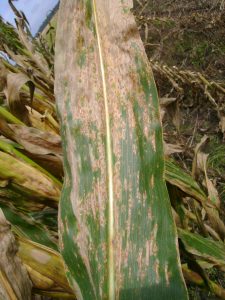Crops are finally starting to pick up growth throughout the state. In parts of the south we have tasseling corn, while we will hit VT soon in some of the earlier planted corn fields in central and Northern parts of the state. Soybeans are starting to put on growth as well, with some starting to flower in areas.
In corn, field scouting for should begin at least 2 weeks before tasseling and continue until at least 2 to 3 weeks past tasseling. If you haven’t checked your fields and have yet to hit VT, now is a good time to get out there.
There are a few diseases that are just starting to pick up in parts of the state. In the south, we have pockets of Diplodia leaf streak starting up. For an article and images of Diplodia click here. This disease seems to be increasing in incidence in parts of Illinois and other surrounding states. If you have any suspect samples, feel free to sent it to our lab or the University of Illinois Plant Diagnostic Clinic.
Common rust can be found at extremely low levels and as I mentioned in a previous article I wrote for The Bulletin, this isn’t something to be too concerned about in the majority of cases.
Grey leaf spot is starting in many fields, although I have not seen or heard of reports of severe infections. Last year the environment was extremely conducive for this disease, and it was easily the most impactful issue in Illinois last year. As corn approaches VT, keep scouting for this disease. Lesions are rectangular, limited by the veins, and can range from brown to grey depending on age and other factors. Grey leaf spot does best in warm (75-85F), humid conditions and frequent rainfall. This pathogen has a long latent period after infection when symptoms are not visible. This period may last from 2 to 4 weeks.
Northern corn leaf blight is hard to find, but it is out there at low levels. Remember that this one produces larger, cigar-shaped lesions. Northern corn leaf blight does better under more moderate temperatures (64-81F) compared to grey leaf spot, but similar to that disease, needs persistent, high humidity to infect.
There have not been any tar spot confirmations in Illinois or any surrounding states. However, there have been an abundance of tar spot lookalikes. The most frequent culprit is insect frass/feces, meaning that our insect populations are eating well and are regular. Most often, individuals will see small, round, shiny to matte, black dots at very low amounts on a small number of plants in the field. Sometimes these dots can be 1/8 inch or more if an extremely productive insect was involved. The easiest way to check suspect tar spot leaves it to take it back to your vehicle and wet the leaves with some water, then gently rub the spots between your fingers. Insect crud will wash off, tar spot stroma will not. Alternatively, you can often scrape the feces off with your fingernail. Still not sure? Send off a sample to the clinic. Some other tar spot lookalikes have been what may be early infections by other diseases and dried up or old common rust pustules. Again, if you aren’t sure, send it off for examination. Pictures can be deceiving.
Soybean diseases have been few and far between. I thought we may see more Phytophthora this season given the warm wet conditions during planting, but that prediction thankfully has not come true. I guess I need to purchase a new Magic 8 Ball. There have been some disease lookalikes, such as herbicide damage, as well as Phyllosticta in a few areas. Phyllosticta can look like frogeye leaf spot, but instead of a silvery or grey mass on the underside of lesions, black specks are visible inside the lesions. Phyllosticta tends to like cool, wet conditions and is not considered to be of significant economic importance.
In parts of Northern Illinois soybeans will be flowering soon. This means that white mold management decisions should be on your radar. The Sporecaster tool can help you with in season management decisions. To download this app for your phone, click here.
Continue to scout your fields and let us know if anything odd pops up! You can always email me images or send images to me on twitter @ILplantdoc. Phone calls are always welcome.


